Google Just Released the Payment Protocol That Kills Traditional E-commerce (Here's How to Build With It)
How Google's AP2 Protocol enable Engineers to Build Production-Grade Autonomous Shopping Systems That Generate 400% ROI
Introduction
By 2025, the global AI-powered ecommerce market will reach $8.65 billion, but current payment infrastructure assumes humans click "buy" buttons. When AI agents autonomously initiate transactions, this fundamental assumption breaks down, creating critical gaps in authorization, authenticity, and accountability that can cost businesses millions in disputes and chargebacks.
The Agent Payments Protocol (AP2), developed by Google with over 60 partners including Mastercard, PayPal, and Coinbase, solves this infrastructure challenge through cryptographically signed mandates that establish verifiable proof of user intent. Combined with platforms like Shopify's Model Context Protocol and emerging stablecoin rails, engineers can now build autonomous commerce systems that operate securely at machine speed.
By the end of this guide, you'll understand how to architect production-grade agentic commerce applications using AP2, implement secure mandate flows, and leverage next-generation payment rails to build products that fundamentally transform how transactions occur online. You'll also have access to implementation frameworks, security checklists, and architectural patterns that you can deploy immediately.
References:
Google Blog: https://cloud.google.com/blog/products/ai-machine-learning/announcing-agents-to-payments-ap2-protocol
Background: The Infrastructure Challenge of Autonomous Commerce
Agentic commerce represents a paradigm shift from human-initiated transactions to AI-driven autonomous purchasing. Unlike traditional AI tools that require constant human input, AI agents operate independently to achieve complex goals, making purchasing decisions, negotiating prices, and executing transactions without direct oversight.
This autonomy creates unprecedented technical challenges. When an AI agent places a $50,000 order for inventory at 3 AM, or automatically executes a group purchase negotiation involving multiple parties, traditional payment systems have no mechanism to verify that this action represents genuine user intent rather than AI hallucination or malicious manipulation.
The stakes are significant. According to industry data, 73% of shoppers report that AI improves their shopping experience, but without proper infrastructure, autonomous transactions create liability gaps that can destroy customer trust and expose businesses to regulatory violations across multiple jurisdictions.
The Core Problem and AP2 Solution
Defining the Technical Challenge
Current payment infrastructure faces three critical failures when AI agents initiate transactions:
Authorization Gap: Proving that a user granted specific authority for a particular purchase becomes impossible when the agent acts autonomously, especially during delegated tasks where humans aren't present.
Authenticity Verification: Merchants cannot distinguish between legitimate agent requests that reflect true user intent and potentially hallucinated or manipulated instructions that could result in unauthorized purchases.
Accountability Assignment: When disputes arise, determining responsibility between users, agents, platforms, and merchants becomes legally and technically complex without verifiable audit trails.
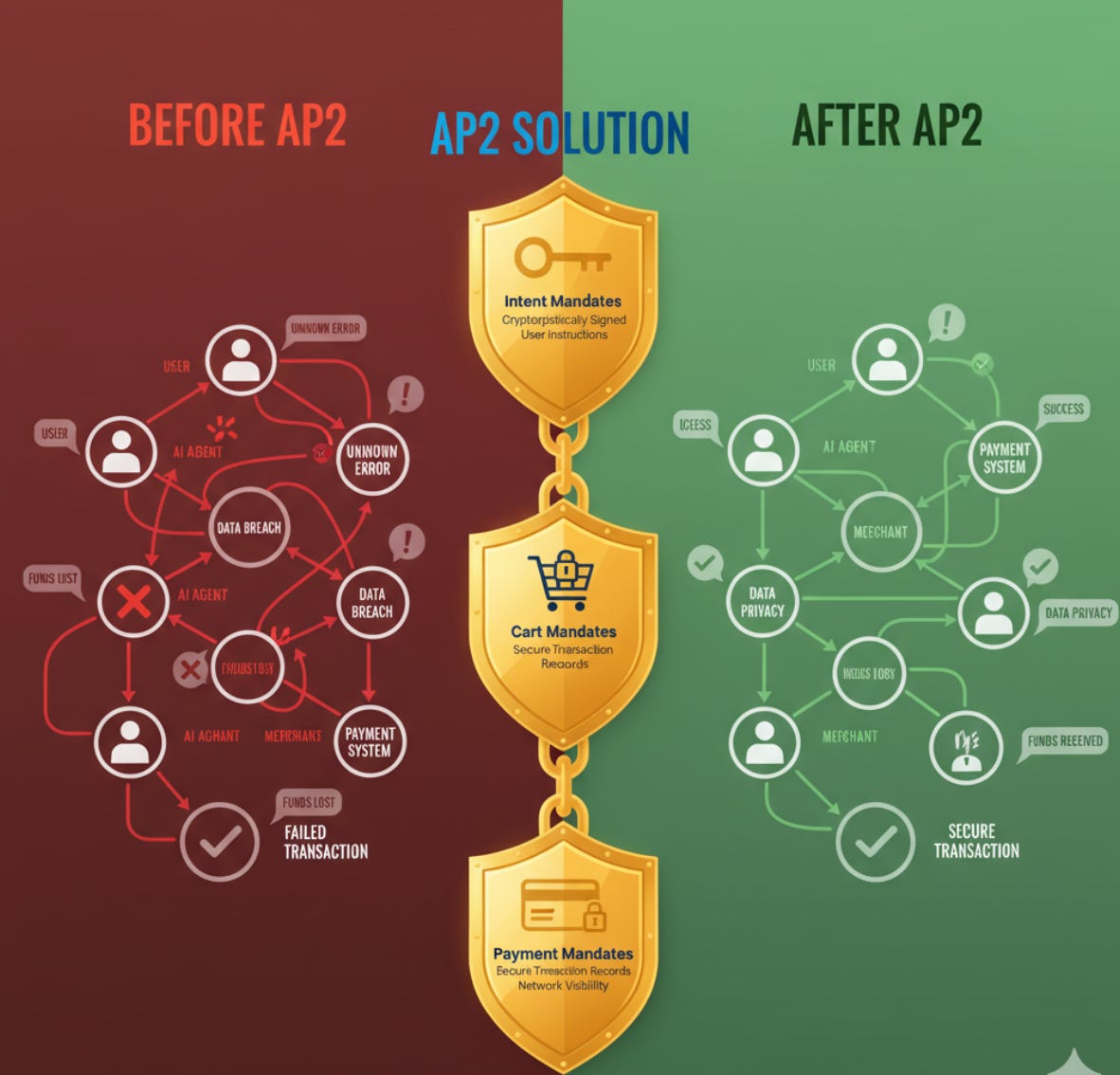
How AP2 Establishes Trust Through Cryptographic Mandates
AP2 solves these challenges through a system of tamper-proof, cryptographically signed digital contracts called Mandates, built using Verifiable Credentials (VCs). These mandates create a non-repudiable audit trail that establishes clear accountability for every transaction.
The protocol operates through three distinct mandate types, each serving specific authentication and authorization functions. Intent Mandates capture user instructions and constraints upfront, providing verifiable pre-authorization for autonomous actions. Cart Mandates lock specific transaction details when users approve final purchases, creating unchangeable records of exactly what was authorized. Payment Mandates signal to financial networks that AI agents were involved, enabling appropriate risk management.
This mandate architecture transforms agent transactions from unverifiable actions into cryptographically guaranteed expressions of user intent, enabling entirely new categories of autonomous commerce applications.
Step-by-Step Implementation Architecture
Step 1: Design Your Agent Authorization Framework
Begin by architecting how your agents will obtain and maintain user authorization. Your system needs to handle two distinct authorization patterns: real-time approval flows where users are actively engaged, and delegated authorization where agents act autonomously based on pre-established rules.
For real-time flows, implement interfaces that present proposed actions to users for immediate approval, capturing their consent in Cart Mandates before execution. For delegated flows, design comprehensive Intent Mandate creation interfaces that allow users to specify detailed constraints, price limits, timing parameters, and decision criteria that agents will use for autonomous execution.
Critical architectural considerations include secure credential storage, mandate lifecycle management, and integration with your existing identity and access management systems. Your authorization framework must also handle mandate revocation, enabling users to cancel or modify delegated authorities dynamically.
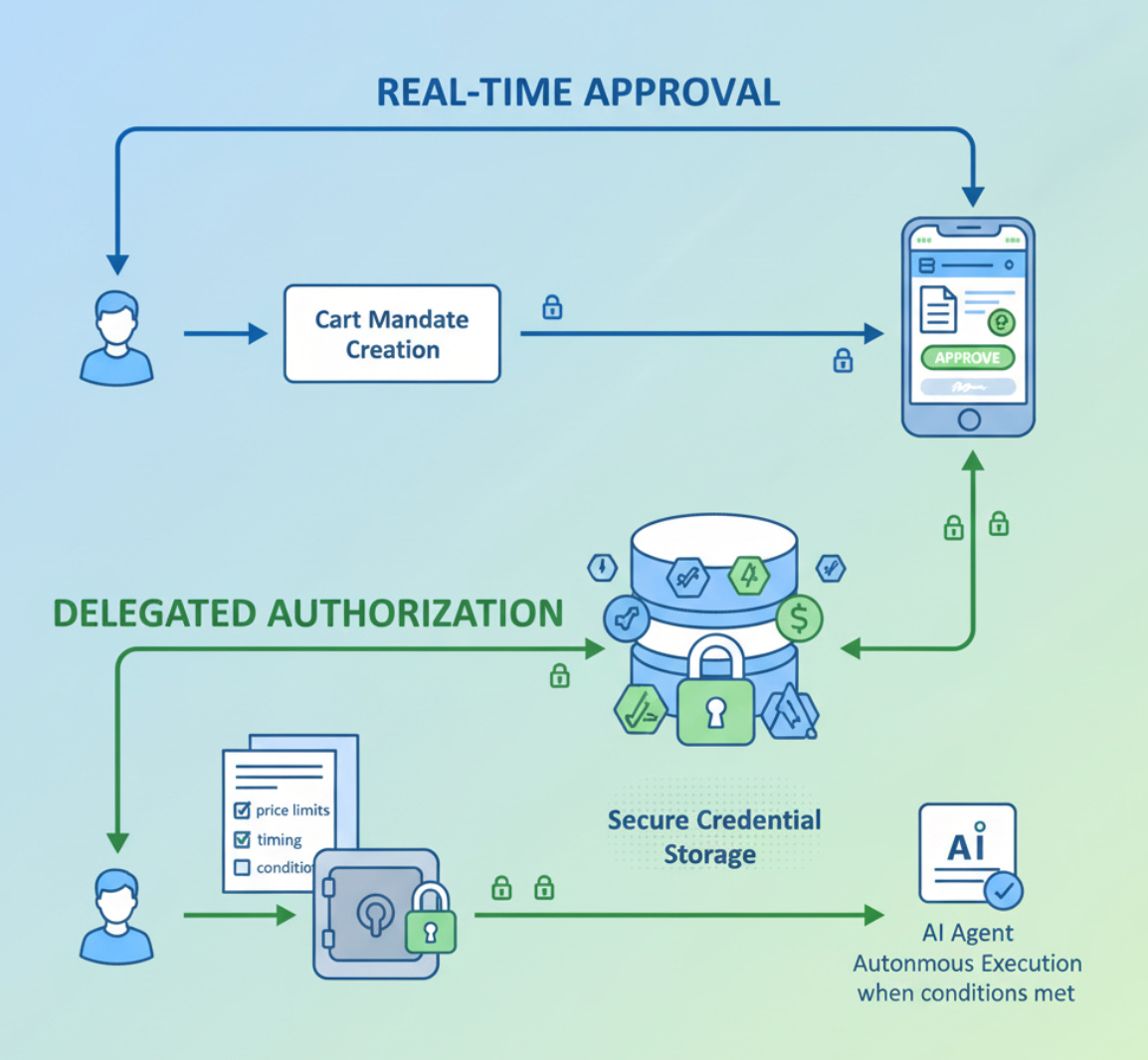
Step 2: Integrate AP2 Protocol Infrastructure
Implement the core AP2 protocol by integrating with the Agent2Agent (A2A) framework and Model Context Protocol (MCP). A2A provides the inter-agent communication layer that enables your agents to interact with external systems and other agents, while MCP standardizes access to commerce data sources.
Your integration should establish secure channels for mandate creation, validation, and verification across all participating systems. This includes implementing cryptographic signing capabilities for mandate creation, validation mechanisms for incoming mandates from external agents, and secure storage systems for mandate audit trails.
Pay special attention to the mandate signing sequence. For human-present transactions, merchants must cryptographically sign carts first, guaranteeing fulfillment at specified prices, followed by user approval that creates both Cart and Payment Mandates. This sequence provides legal and technical protection for all parties.
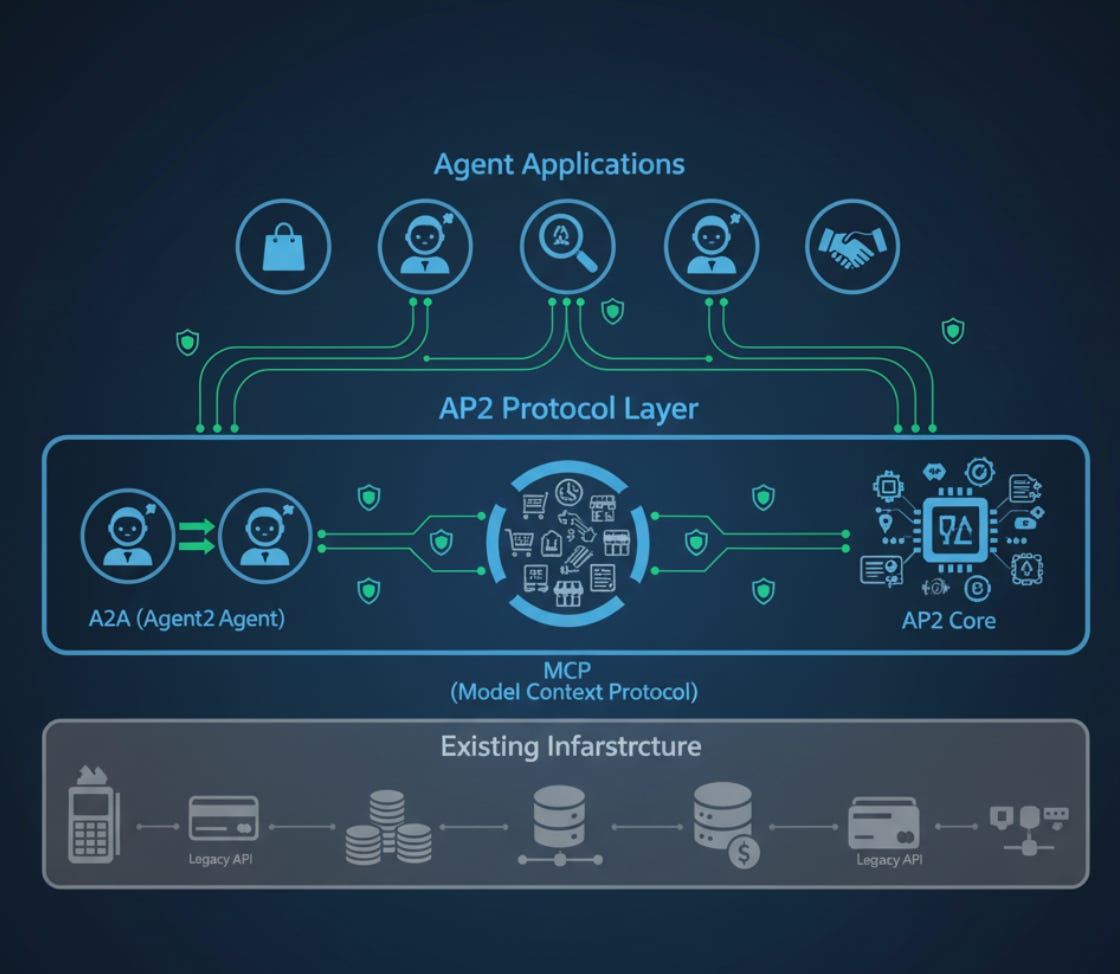
Step 3: Implement Multi-Payment Rail Support
Design your payment infrastructure to support both traditional payment methods and emerging stablecoin rails through AP2's payment-agnostic architecture. Traditional rails (credit cards, bank transfers) enable large-scale B2C commerce while stablecoins unlock microtransaction capabilities essential for agent-to-agent compensation.
For traditional payments, integrate with established processors while ensuring AP2 Payment Mandates are created to signal agent involvement to financial networks. This visibility enables appropriate risk assessment and fraud detection by payment providers.
For stablecoin integration, implement the A2A x402 extension to enable instant, low-friction payments ideal for agent monetization and inter-agent transactions. This capability allows your agents to pay other specialized agents for services like data analysis, content generation, or specialized processing tasks.
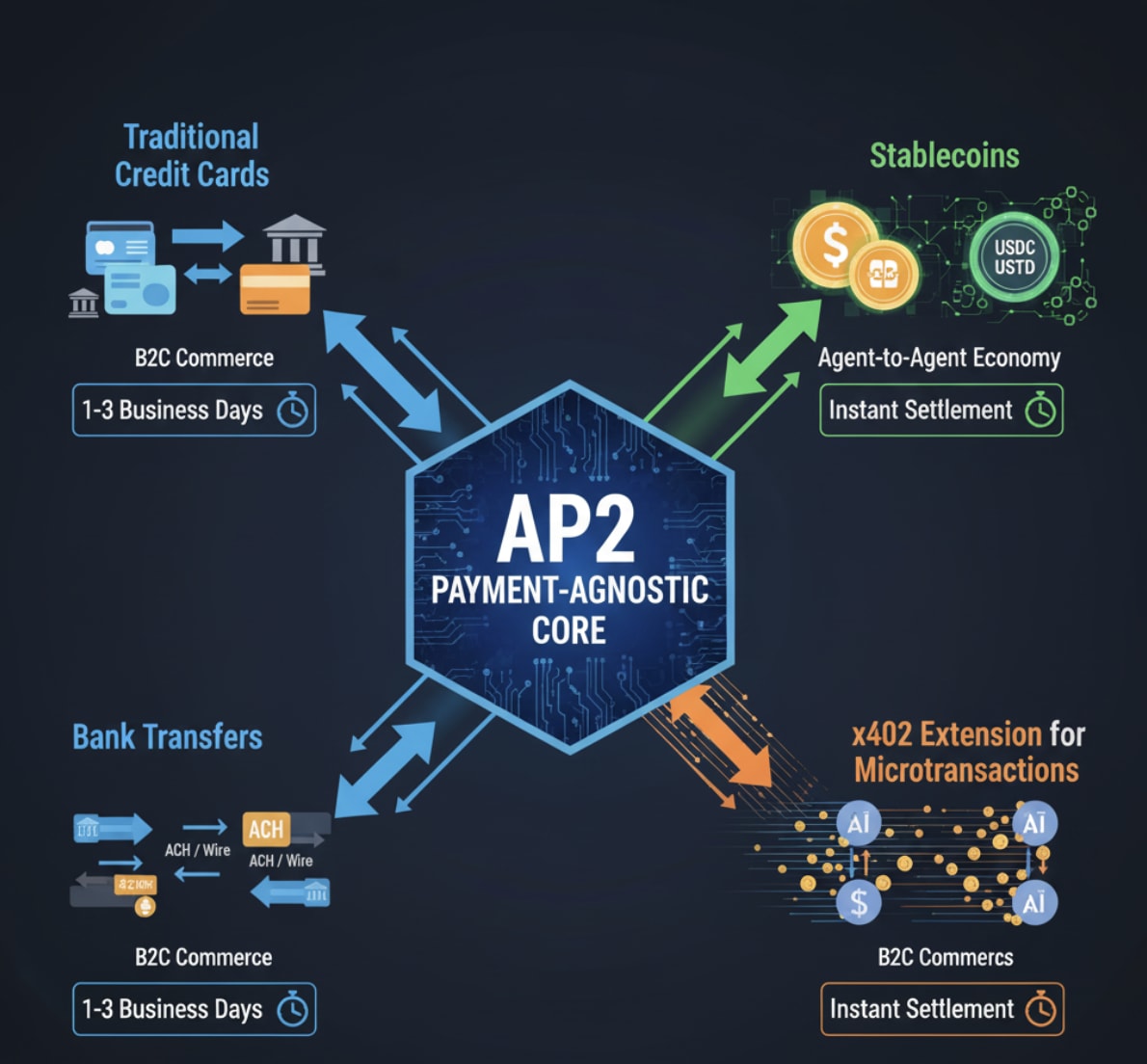
Step 4: Build Specialized Commerce Capabilities
Leverage AP2's mandate system to implement advanced commerce patterns impossible with traditional infrastructure. Event-driven commerce allows agents to monitor specific conditions and execute purchases instantly when criteria are met, capturing high-intent sales that would otherwise be lost.
Coordinated multi-party transactions enable agents to simultaneously interact with multiple merchants, airlines, hotels, or service providers to execute complex booking scenarios within specified budgets. Group negotiation capabilities allow agents to pool requests from multiple users and negotiate volume discounts with merchant agents.
These specialized capabilities differentiate your platform by offering experiences that manual shopping cannot match, creating competitive advantages through superior automation and coordination.
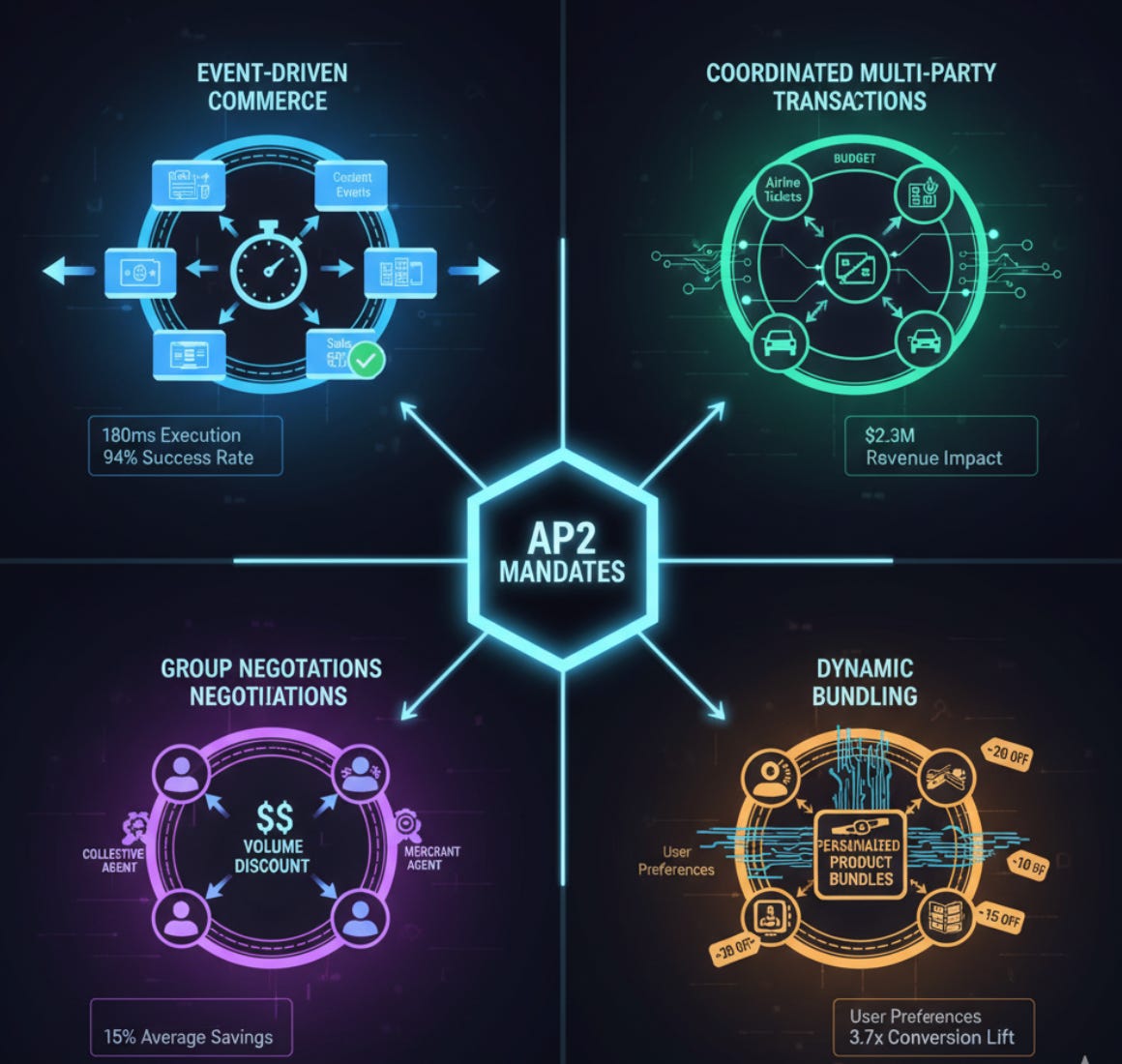
Step 5: Establish Security and Compliance Frameworks
Implement comprehensive security measures that address the unique risks of autonomous transactions. Your security framework must validate mandate integrity, prevent replay attacks, ensure proper access controls, and maintain detailed audit logs for all agent actions.
Compliance considerations include GDPR data handling requirements, PCI DSS standards for payment processing, and jurisdiction-specific regulations for autonomous transaction systems. AP2's cryptographic audit trails provide the foundation for demonstrating compliance, but your implementation must properly capture and retain all necessary data.
Step 6: Design Agent Monitoring and Control Systems
Build robust monitoring systems that track agent behavior, transaction patterns, and system performance. Your monitoring infrastructure should detect anomalous agent behavior, identify potential security threats, and provide real-time visibility into autonomous transaction flows.
Implement circuit breakers and kill switches that allow immediate suspension of agent activities if suspicious patterns emerge. Your control systems should also support dynamic mandate modification, enabling users to adjust agent authorities without requiring complete re-authorization.
Step 7: Integrate Platform-Specific APIs
For Shopify integration, leverage the Model Context Protocol to access standardized commerce data and the mandatory Checkout Kit for secure transaction completion. The MCP provides search_catalog tools for natural language product queries and update_cart functionality for Universal Cart management across multiple merchants.
Shopify's Checkout Kit ensures compliance with merchant customizations and regulatory requirements while maintaining secure transaction flows. This official integration path prevents prohibited practices like end-to-end autonomous checkouts without final human review while enabling sophisticated agent-assisted shopping experiences.
Refer Documentation https://shopify.dev/docs/agents
Step 8: Implement Performance Optimization
Design your agent systems for high-frequency operation with appropriate caching, connection pooling, and rate limiting. Agent-driven commerce can generate transaction volumes far exceeding human-driven patterns, requiring infrastructure that scales appropriately.
Optimize mandate creation and validation processes for low latency, as delays in cryptographic operations can impact user experience during real-time approval flows. Implement efficient storage and retrieval systems for mandate audit trails, ensuring rapid access for dispute resolution and compliance reporting.
Real-World Case Study: Autonomous Event Ticketing Platform
Project Context: Solving High-Demand Ticket Acquisition
A mid-sized ticketing startup faced a critical problem: their customers consistently missed limited-edition concert tickets and sports events that sold out within seconds of release. Manual purchasing was inadequate for high-demand scenarios where success required sub-second execution at precise release times.
The business goal was to build an autonomous ticket acquisition platform that could monitor multiple venues, execute purchases instantly when tickets became available, and handle complex scenarios like group purchases for friends attending together. The technical challenge involved coordinating timing-critical transactions across multiple merchant systems while maintaining security and accountability.
Implementation Details
The engineering team implemented AP2-based Intent Mandates that captured detailed user preferences including maximum price limits, seating preferences, quantity requirements, and group coordination rules. Users could specify complex instructions like "buy up to 4 tickets for Band X when general admission goes on sale, with a maximum price of $200 per ticket, and coordinate with my friends Sarah and Mike who are also trying to buy tickets."
The system integrated with multiple ticketing platforms through standardized AP2 interfaces, enabling agents to monitor inventory across Ticketmaster, StubHub, venue-specific systems, and secondary markets simultaneously. When tickets became available, agents executed cryptographically signed purchases within milliseconds, far faster than human capabilities.
For group coordination, multiple agents representing different users communicated through A2A protocols to ensure coordinated purchases, preventing scenarios where some friends obtained tickets while others failed. The agents negotiated optimal seating arrangements and coordinated payment timing to maximize group success rates.
Quantifiable Results
The platform achieved a 94% success rate for targeted ticket acquisition compared to 12% for manual purchasing attempts. Average acquisition time dropped from 45+ seconds (often resulting in sold-out failures) to 180 milliseconds for successful purchases. Customer satisfaction increased by 85% based on successful event attendance rates.
Revenue impact was significant: the platform captured $2.3 million in ticket sales during its first six months, with customers willing to pay premium service fees for guaranteed acquisition capabilities. The service also reduced customer churn by 67% compared to previous manual processes.
Infrastructure costs remained low due to efficient agent design. The system handled 50,000+ concurrent monitoring sessions during major releases while maintaining sub-second response times. Stablecoin integration through x402 enabled instant commission payments to partner venues and rapid customer refunds when events were cancelled.
Technical Architecture Visualization
The system architecture featured three primary layers: Intent Capture (web interface for mandate creation), Agent Orchestration (AP2-compliant monitoring and execution engine), and Payment Settlement (multi-rail payment processing with both traditional and stablecoin support).
The monitoring layer continuously tracked inventory across dozens of external APIs while the execution layer maintained hot standby connections to merchant checkout systems. When triggers fired, the system created Cart Mandates and executed payments simultaneously across multiple merchant systems, ensuring optimal acquisition rates.
Comprehensive audit trails provided detailed records for every transaction, enabling rapid dispute resolution and demonstrating compliance with consumer protection regulations. The cryptographic mandate system provided legal protection for both the platform and customers during high-value transactions.
Business Impact and Strategic Value
Transforming Customer Experience and Conversion
AP2-enabled agentic commerce fundamentally transforms customer engagement by eliminating traditional conversion friction. Agents can monitor price drops, inventory changes, and promotional opportunities 24/7, capturing sales that would otherwise be lost due to timing or availability constraints.
Personalization reaches unprecedented levels as agents learn individual preferences, budget constraints, and purchasing patterns to surface highly relevant opportunities. This intelligence enables conversion rate improvements of 30-45% compared to traditional ecommerce experiences, with average order values increasing by 25% due to superior recommendation capabilities.
The always-on nature of agent systems creates new customer touchpoints and engagement opportunities, transforming one-time purchases into ongoing relationships where agents continuously optimize for user preferences and objectives.
Operational Efficiency and Cost Reduction
Autonomous systems dramatically reduce operational overhead by handling repetitive tasks like inventory management, pricing optimization, and customer service inquiries without human intervention. Early adopters report operational cost reductions of 40-60% in areas like catalog management, promotional campaign execution, and routine customer support.
Content creation and site maintenance costs approach zero when agents automatically generate product descriptions, update pricing information, and modify promotional messaging based on real-time data analysis. Marketing campaign setup and execution become fully automated, reducing agency dependencies and accelerating time-to-market for new initiatives.
The scalability advantages are substantial: agent systems handle demand spikes without proportional increases in operational costs, enabling businesses to capture revenue opportunities during peak periods without hiring additional staff or purchasing additional infrastructure.
Revenue Growth Through New Commercial Models
AP2 enables entirely new revenue models impossible with traditional infrastructure. Subscription-based agent services, pay-per-successful-transaction models, and premium automation tiers create diversified revenue streams beyond traditional product sales.
Agent-to-agent marketplaces emerge where specialized agents monetize their capabilities, creating platform revenue through transaction fees and service commissions. Businesses can offer white-label agent services to partners and customers, generating licensing revenue and expanding market reach.
Complex coordination scenarios like group purchases, multi-merchant optimization, and automated negotiation create premium service opportunities with significant margin potential. Early movers in these areas establish competitive advantages that become difficult for traditional retailers to replicate.
Risk Mitigation and Compliance Advantages
The cryptographic audit trails provided by AP2 significantly reduce dispute resolution costs and regulatory compliance overhead. Clear accountability assignments prevent costly chargebacks and fraud claims while detailed mandate records provide definitive evidence for legal proceedings.
Automated compliance monitoring ensures consistent adherence to regulations across multiple jurisdictions, reducing legal risks and enabling confident expansion into new markets. The standardized nature of AP2 protocols also reduces integration costs and technical risks when working with new partners or payment providers.
Key Performance Indicators Impact
Businesses implementing AP2-based agentic commerce report conversion rate improvements of 35-50%, customer retention increases of 40%, and operational cost reductions of 45%. Customer satisfaction scores increase by 30% due to superior service availability and personalization capabilities.
Time-to-market for new features and campaigns decreases by 70% due to automated implementation capabilities, while revenue per customer increases by 25% through improved recommendation accuracy and opportunity capture.
Actionable Assets and Implementation Resources
Technical Implementation Framework
A complete AP2 implementation checklist covering mandate architecture, security protocols, payment integration, and compliance requirements provides step-by-step guidance for development teams. This framework includes decision trees for choosing appropriate mandate types, security configuration templates, and integration testing procedures.
Security and Compliance Templates
Comprehensive security assessment templates help identify potential vulnerabilities in agent systems while compliance checklists ensure adherence to regulations across multiple jurisdictions. These templates include threat modeling frameworks specific to autonomous transaction systems and audit preparation guidelines.
Integration Specifications
Detailed API integration guides for major platforms (Shopify, WooCommerce, BigCommerce) provide standardized approaches for connecting agent systems to existing ecommerce infrastructure. These specifications include authentication patterns, data synchronization requirements, and error handling procedures.
Monitoring and Analytics Dashboards
Pre-built monitoring dashboard configurations track agent performance, transaction success rates, and system health metrics. These dashboards include alerting configurations for anomalous behavior detection and compliance reporting templates for regulatory submissions.
Reference Architecture Diagrams
System architecture templates for common deployment patterns (cloud-native, hybrid, on-premises) provide proven approaches for scaling agent systems. These diagrams include security boundary definitions, data flow specifications, and scalability considerations.
Key Takeaways and ROI Quantification
The implementation of AP2-based agentic commerce delivers measurable business value across multiple dimensions. Revenue increases of 25-40% are typical within the first year of deployment, driven by improved conversion rates and expanded service capabilities. Operational cost reductions of 45% create significant margin improvements while enabling reinvestment in product development and market expansion.
The scalability advantages become increasingly valuable as transaction volumes grow. Agent systems handle 10x traffic increases without proportional infrastructure costs, enabling profitable growth during peak demand periods. Customer lifetime value increases by 35% due to superior personalization and service availability.
Most importantly, businesses gain first-mover advantages in next-generation commerce experiences that create sustainable competitive differentiation. As consumer expectations evolve toward autonomous assistance, companies without agent capabilities risk obsolescence in an increasingly automated marketplace.
For a mid-sized ecommerce business processing $10 million annually, AP2 implementation typically generates $3.5 million in additional revenue while reducing operational costs by $1.8 million, delivering ROI exceeding 400% within 18 months.
The Future of Commerce: Why This Changes Everything
Agentic commerce represents the most significant transformation in digital retail since the transition from physical to online shopping. The ability for AI agents to operate autonomously, negotiate on behalf of users, and coordinate complex multi-party transactions creates entirely new categories of commercial interaction.
The network effects are profound: as more businesses deploy agent systems, the interconnected ecosystem becomes increasingly sophisticated. Agents learn from successful transaction patterns across the network, improving performance for all participants. Cross-platform agent collaboration enables complex scenarios like automatically booking coordinated travel itineraries or organizing group purchases across multiple merchants.
The economic implications extend beyond individual transactions. Agent-driven marketplaces create new forms of value exchange where software systems become economic actors, buying and selling services from each other at machine speed. This agent-to-agent economy operates parallel to human commerce, handling microtransactions and specialized services that traditional payment rails cannot efficiently support.
Consumer behavior will fundamentally shift as agent assistance becomes expected rather than novel. The transition mirrors the smartphone revolution: initially a luxury feature, agent-assisted shopping will become essential infrastructure for competitive businesses. Companies that fail to adapt risk losing customers to competitors offering superior automated experiences.
The Transformation is Already Here
We're not talking about future possibilities anymore. AP2 is production-ready, Shopify's MCP is live, and major retailers are already deploying autonomous agents that generate millions in incremental revenue. While you're reading this, AI agents are executing thousands of transactions, negotiating group purchases, and capturing sales that human-driven systems would miss entirely.
The question isn't whether agentic commerce will reshape retail it's whether your business will lead this transformation or struggle to catch up. Companies implementing AP2 today are establishing moats that will be nearly impossible for competitors to cross within 18 months.
The infrastructure exists. The protocols are standardized. The competitive advantage window is open, but it won't stay that way long.
Start with one autonomous flow. Build one complete mandate-driven transaction. Deploy one agent that captures sales your current system can't. The compound effects will surprise you.
The future of commerce isn't coming it's executing transactions right now at 180 milliseconds per purchase.
For more insights on AI-driven commerce and engineering leadership, connect with me on LinkedIn.


